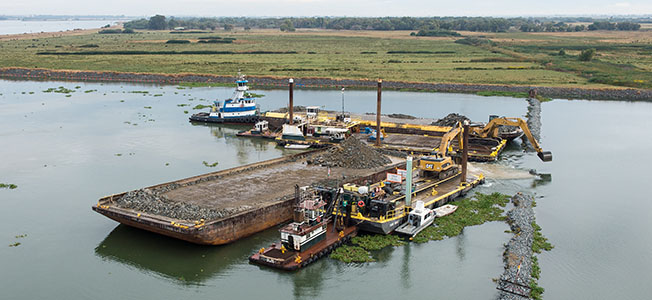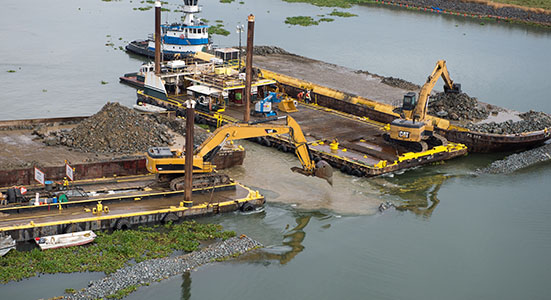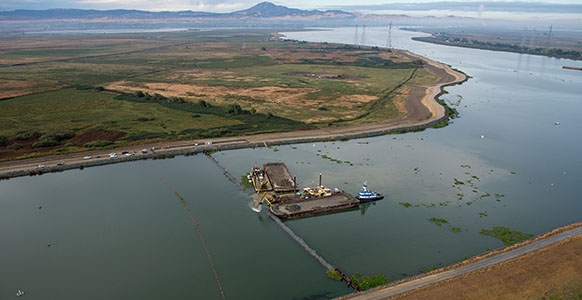In June, Bay Crossings reported that a temporary rock barrier across a Sacramento-San Joaquin Delta channel was constructed due to potentially insufficient water supplies to repel salinity in the Delta. San Rafael-based Dutra Group installed the single emergency salinity barrier across West False River and has now begun removing it.

In early October, water began flowing over what remains of the salinity barrier that was completed in June to preserve Delta water quality and conserve water in upstream reservoirs that otherwise would have been released to help block incoming tides of salty water from San Francisco Bay.
BC Staff Report
Published: November, 2015
In June, Bay Crossings reported that a temporary rock barrier across a Sacramento-San Joaquin Delta channel was constructed due to potentially insufficient water supplies to repel salinity in the Delta. San Rafael-based Dutra Group installed the single emergency salinity barrier across West False River and has now begun removing it.
The barrier was erected to block salt water from pushing into the Delta from San Francisco Bay. The Delta’s water is used by 25 million Californians, including residents of the Delta and Contra Costa, Alameda and Santa Clara counties. The California Department of Water Resources’ (DWR) State Water Project and the federal Central Valley Project convey Delta water through their aqueducts to distant parts of the state.
Last month, DWR had the Dutra Group return to the site to dismantle the emergency drought barrier located between Jersey and Bradford islands. The Dutra family has been working in the Delta since the early 1900s performing numerous repairs to levee breaches, which are comparable to the installation of the salinity barrier.
A fourth year of drought made installation of the barrier necessary to preserve Delta water quality and conserve water in upstream reservoirs that otherwise would have been released to help block incoming tides of salty water from San Francisco Bay. Permits issued to DWR for installation of the barrier require removal in November due to fishery and potential flood concerns.
Dismantling of the approximately 750-foot rock barrier began on September 8 and will be completed by mid-November. About 150,000 tons of large rocks (riprap) taken from the Dutra rock quarry in San Rafael were used to build the barrier. By the beginning of October, cranes had removed about 22,000 tons of riprap on the downstream side of the barrier along its length between the West False River’s banks, thereby narrowing the width while not lowering the barrier’s height.
Bryan O’Sullivan, Dutra’s project manager, said, “Both the installation and removal of the salinity barrier had extremely tight timelines. Redundancy had to be built in to our work plans to ensure continued operation if something went wrong.”
Continued removal of the riprap allowed water to begin flowing over what remained of the barrier while dismantling of the remaining submerged portions of the barrier will continue until all of it is removed and boating restrictions end at that location. According to O’Sullivan, “The velocity of water flowing over a partially complete barrier meant all barge and boat moves needed to be thoroughly planned around the tides.”
The removed riprap will be stored near Rio Vista for possible use if drought conditions continue and installation of an emergency drought barrier once again becomes necessary to preserve water quality.
The barrier was an essential part of DWR’s strategy to maintain good water quality in the Delta and preserve water in upstream reservoirs to help keep young salmon cool enough to stay alive downstream of dams. Construction, monitoring, mitigation and removal are estimated to cost roughly $28 million, to be paid for with a mix of funding from Proposition 50, a $3.4 billion water bond approved by voters in November 2002, and general fund dollars. Removal is expected to take 45 to 60 days. DWR last used emergency drought barriers to reduce salinity intrusion in 1976-77.
Conservation—the wise, sparing use of water—remains California’s most reliable drought management tool. The three-year period from 2012 through 2014 was the driest three-year period on record in California, and 2015 opened with the driest January in the state’s history. The Sierra Nevada snowpack typically peaks by April 1; this year, the snowpack was measured at five percent of historic average, the lowest measurement in recorded history.
Paul Marshall, chief of DWR’s Bay-Delta Office, said the barrier performed as expected based on DWR’s computer modeling. “The water users in the interior of the Delta, including many farmers and residents there, would have experienced much higher salinity without it,” he said. “The barrier has achieved what we intended, and having it go in by early June helped us to counter high tides experienced later that month.”
All photos courtesy of CA Department of Water Resources

Complete removal of the 750-foot-wide salinity barrier is expected to take 45-60 days and be done by mid-November.

The salinity barrier was an essential part of the California Department of Water Resourcesí strategy to maintain good water quality in the Delta and preserve water in upstream reservoirs to help keep young salmon cool enough to stay alive downstream of dams.

